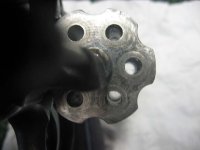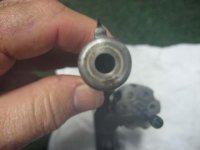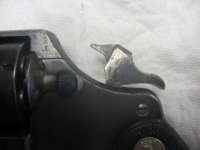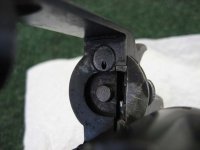I have come across an old Colt Army Special that is in fair to good condition but the barrel and cylinders have been sleeved to accept 22 cal. Is this something that would have been done at the factory? How does this affect the value? sn#336xxx. Any feedback would be appreciated, Thanks, G
You are using an out of date browser. It may not display this or other websites correctly.
You should upgrade or use an alternative browser.
You should upgrade or use an alternative browser.
Colt Army Special
- Thread starter glassguy
- Start date
No, it is an after-market job. Too bad; those older DA Colts are beginning to catch on with collectors when they were scorned for so long.
The Army Special was made in .38 Special, .32-20 and .41 Colt. Yours would date to 1911. It was the successor to the New Model Army and Navy revolver and was followed by the Official Police which was the same gun only with the name changed.
Jim
The Army Special was made in .38 Special, .32-20 and .41 Colt. Yours would date to 1911. It was the successor to the New Model Army and Navy revolver and was followed by the Official Police which was the same gun only with the name changed.
Jim
Dfariswheel
New member
Because the gun is no longer in original condition and has been extensively altered, it's almost impossible to assign a valid value.
This is one of those "whatever someone will give you" things.
An original Army Special in "fair to good" would be worth around $175. An altered gun, somewhat less than that.
This is one of those "whatever someone will give you" things.
An original Army Special in "fair to good" would be worth around $175. An altered gun, somewhat less than that.
spacecoast
New member
I'm very fond of my Army Special (a 1922 .38 special), I wonder if the conversion is something that is a one-off or if someone sold kits to do that at one time. It seems like the conversion from centerfire to rimfire would be a little tricky.


Bob Wright
New member
Around the early 'Fifties I saw quite a few revolvers sleeved to smaller caliber. Many of these were Webley Royal Irish Constabulary revolvers orignially .442 RIC sleeved to take .25-20 cartridges. And a few to .22 R.F. The .22s I saw had the chamber angled slightly so the centerfire firing pin struck the bottom of the rim of the cartridge in line with the barrel.
Didn't fire any of these so don't know what that did to accuracy.
Bob WRight
Didn't fire any of these so don't know what that did to accuracy.
Bob WRight
I never heard of any kit to convert any of those revolvers to .22 caliber RF; it would have been a one-off gunsmith job. At one time, Numrich sold leftover* Colt barrels and cylinders in .38 Special and .357 Magnum for the SAA and many of those guns in calibers for which ammunition was no longer made or was scarce were converted. I have no idea how many rare calibers might have been converted at that time, but I suppose a good number were.
That was when Colt had discontinued the SAA and sold off not just parts but the tooling as well. We all know how that turned out.
Jim
That was when Colt had discontinued the SAA and sold off not just parts but the tooling as well. We all know how that turned out.
Jim
bedbugbilly
New member
Personally, I think it would be an interesting pistol and a good shooter. I have a 1910 DOB Army Special in 38 spl. - 6 inch barrel. I love the "vintage" revolvers. While the conversion would obviously affect the value, it would be nice to have one to shoot with the cheaper 22 ammo. I hope the OP will post some photos of it - would be interesting to see what they did to it.
spacecoast
New member
Interesting, do you have a picture of the frame where the hammer comes through?
spacecoast
New member
OK, I don't have my AS with me to compare, but I would say that the hole has been elongated and the hammer nose bent and/or flattened somewhat (or replaced) to impact the top edge (or bottom edge, not sure) of the .22LR case. Interesting conversion.
I've seen a conversion or two similar to this before.
Definitly NOT factory. Probably done by a gunsmith many years ago.
Looks to be a pretty decent job.
Would be a real fun revolver to own, but given that Army Specials don't bring big bucks, and it's been modified, I wouldn't expect it to fetch a whole lot.
I might give $300-ish myself due to the novelty of it ... and it's kind of cool. That's provided it's mechanicly sound.
Maybe someone else would pay more, but that would be top dollar for me.
Definitly NOT factory. Probably done by a gunsmith many years ago.
Looks to be a pretty decent job.
Would be a real fun revolver to own, but given that Army Specials don't bring big bucks, and it's been modified, I wouldn't expect it to fetch a whole lot.
I might give $300-ish myself due to the novelty of it ... and it's kind of cool. That's provided it's mechanicly sound.
Maybe someone else would pay more, but that would be top dollar for me.
Dfariswheel
New member
This is the first time I have seen anything like this. How would the barrel insert have been installed? Solder? Press fit? At this stage of the game I guess this is a permanent alteration.
The way these things used to be made was to drill out the barrel, turn a barrel blank to be a snug fit and soft solder it in place.
Usually a bronze bore brush was used with flux and soft solder to tin the inside of the drilled out barrel, then the liner was tapped in place and the two were heated until the solder melted and soldered it together.
The chambers were done the same way.
When re-lining a barrel today, a Loctite type anaerobic locker is used since it requires no heat.
Another technique to insure the liner doesn't creep forward is to machine a slight flange on the rear of the liner and a corresponding recess in the rear of the barrel.
The slight "step" prevents any chance of the liner from moving forward.
"Back in the day" a number of gunsmiths would convert Colt Single Actions or most any double action revolver to .22LR.
The only tough part when converting a DA revolver was modifying the ejector to work with .22LR ammo.
The way these things used to be made was to drill out the barrel, turn a barrel blank to be a snug fit and soft solder it in place.
Usually a bronze bore brush was used with flux and soft solder to tin the inside of the drilled out barrel, then the liner was tapped in place and the two were heated until the solder melted and soldered it together.
The chambers were done the same way.
When re-lining a barrel today, a Loctite type anaerobic locker is used since it requires no heat.
Another technique to insure the liner doesn't creep forward is to machine a slight flange on the rear of the liner and a corresponding recess in the rear of the barrel.
The slight "step" prevents any chance of the liner from moving forward.
"Back in the day" a number of gunsmiths would convert Colt Single Actions or most any double action revolver to .22LR.
The only tough part when converting a DA revolver was modifying the ejector to work with .22LR ammo.




